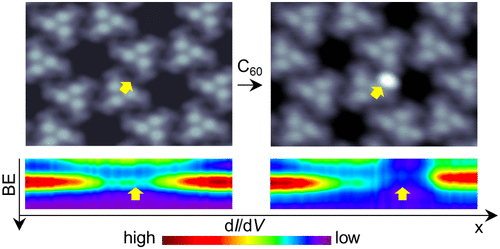Our official English website, www.x-mol.net, welcomes your
feedback! (Note: you will need to create a separate account there.)
Adsorbate-Induced Modification of the Confining Barriers in a Quantum Box Array
ACS Nano ( IF 15.8 ) Pub Date : 2018-01-11 00:00:00 , DOI: 10.1021/acsnano.7b07989 Sylwia Nowakowska 1 , Federico Mazzola 2 , Mariza N. Alberti 3 , Fei Song 4, 5 , Tobias Voigt 3 , Jan Nowakowski 6 , Aneliia Wäckerlin 1 , Christian Wäckerlin 6, 7 , Jérôme Wiss 1 , W. Bernd Schweizer 3 , Max Broszio 3 , Craig Polley 8 , Mats Leandersson 8 , Shadi Fatayer 1, 9 , Toni Ivas 1 , Milos Baljozovic 6 , S. Fatemeh Mousavi 1 , Aisha Ahsan 1 , Thomas Nijs 1 , Olha Popova 1 , Jun Zhang 10 , Matthias Muntwiler 10 , Carlo Thilgen 3 , Meike Stöhr 4 , Igor A. Pasti 11 , Natalia V. Skorodumova 12, 13 , François Diederich 3 , Justin Wells 2 , Thomas A. Jung 6
ACS Nano ( IF 15.8 ) Pub Date : 2018-01-11 00:00:00 , DOI: 10.1021/acsnano.7b07989 Sylwia Nowakowska 1 , Federico Mazzola 2 , Mariza N. Alberti 3 , Fei Song 4, 5 , Tobias Voigt 3 , Jan Nowakowski 6 , Aneliia Wäckerlin 1 , Christian Wäckerlin 6, 7 , Jérôme Wiss 1 , W. Bernd Schweizer 3 , Max Broszio 3 , Craig Polley 8 , Mats Leandersson 8 , Shadi Fatayer 1, 9 , Toni Ivas 1 , Milos Baljozovic 6 , S. Fatemeh Mousavi 1 , Aisha Ahsan 1 , Thomas Nijs 1 , Olha Popova 1 , Jun Zhang 10 , Matthias Muntwiler 10 , Carlo Thilgen 3 , Meike Stöhr 4 , Igor A. Pasti 11 , Natalia V. Skorodumova 12, 13 , François Diederich 3 , Justin Wells 2 , Thomas A. Jung 6
Affiliation

|
Quantum devices depend on addressable elements, which can be modified separately and in their mutual interaction. Self-assembly at surfaces, for example, formation of a porous (metal-) organic network, provides an ideal way to manufacture arrays of identical quantum boxes, arising in this case from the confinement of the electronic (Shockley) surface state within the pores. We show that the electronic quantum box state as well as the interbox coupling can be modified locally to a varying extent by a selective choice of adsorbates, here C60, interacting with the barrier. In view of the wealth of differently acting adsorbates, this approach allows for engineering quantum states in on-surface network architectures.
中文翻译:

吸附剂诱导的量子盒阵列中约束壁的修饰
量子设备取决于可寻址元素,可对其进行单独修改以及相互交互。表面的自组装(例如,形成多孔(金属)有机网络)提供了制造相同量子盒阵列的理想方法,这种情况下,这种情况是由孔内电子(肖克利)表面态的局限引起的。我们表明,通过选择性选择与障碍物相互作用的吸附物(此处为C 60),可以在不同程度上局部修改电子量子盒态以及盒间耦合。考虑到大量不同作用的吸附物,这种方法允许在表面网络体系结构中工程化量子态。
更新日期:2018-01-11
中文翻译:

吸附剂诱导的量子盒阵列中约束壁的修饰
量子设备取决于可寻址元素,可对其进行单独修改以及相互交互。表面的自组装(例如,形成多孔(金属)有机网络)提供了制造相同量子盒阵列的理想方法,这种情况下,这种情况是由孔内电子(肖克利)表面态的局限引起的。我们表明,通过选择性选择与障碍物相互作用的吸附物(此处为C 60),可以在不同程度上局部修改电子量子盒态以及盒间耦合。考虑到大量不同作用的吸附物,这种方法允许在表面网络体系结构中工程化量子态。











































 京公网安备 11010802027423号
京公网安备 11010802027423号